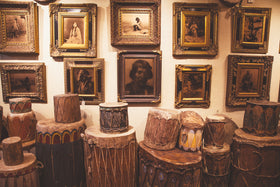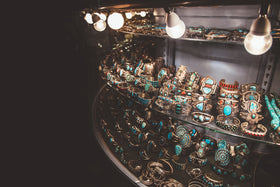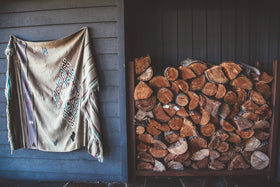History of the Horse in North America

Interestingly enough, many Native Americans believe the legends about where their horses came from - given to them by their highest god for their survival or as a reward. The reality is that the horse evolved in America but became extinct between 8,000 and 12,000 years ago.

Watching The Pass by Gary Lynn Roberts
Oil on canvas, 9" x 12"
When we think of Indians, we often picture a warrior with a spear or bow riding a horse, but the Indians did not always have horses. When the Spanish explorers arrived on the American mainland in the 16th century, they re-introduced horses to the continent.
The horse was indispensable to the conquest of Mexico by Cortez. Indians of that area had never seen horses and to them the horse and rider were a god-like being. To propagate this belief, it was illegal for many years for an Indian to ride a horse, much less to own one. The Spanish brought herds of sheep, cattle, and horses to pasture on the desert ranges. Herding these animals was an endless task, for there were no fences of any kind nor was there adequate material for building them. Even the cultivated fields went unfenced for lack of material. Herdsmen were needed day and night to keep the flocks and herds from straying, protect the animals from predators, and to keep them out of the growing crops. Indian herdsmen proved adept at managing the livestock, moving them to fresh pastures and keeping them away from the fields.
In 1680, the Pueblo Indians rose up against their masters. On the appointed day, the Pueblos attacked at many points in northern New Mexico. The 2,500 survivors withdrew to El Paso but they had lost their homes, their farms, and all their herds to the Pueblos.
The Pueblo Indians found the horse herds hard to manage on the range and they ate the grass needed for sheep. Moreover, the Pueblos had no use for as many horses as the Spanish had abandoned. They were willing to trade large numbers to the Plains tribes and to the Navajos and Utes from the northwest regions.

Women on the Prairie by Sheryl Bodily
Oil on board, 6" x 12"
Acquisition of horses by the Plains Indians in the early 18th century transformed the lives of most tribes between the Rockies and the Mississippi. Almost overnight, they found a much more effective way of hunting the buffalo, which was the main staple in this large region. These tribes embraced the horseback riding culture enthusiastically. Horses made life far easier, richer and more exciting for them. One good horseman could kill enough buffalo in a morning's hunt to supply his family with meat for weeks and robes for a year. Now teepees could be much larger, for a horse could carry a lodge-covering weighing 200 to 300 pounds and drag the many long teepee poles needed to support it.

The Proud Ones by Charles Damrow
Oil on canvas, 48" x 60"
Every warrior had his war-horse, which was the fleetest that could be obtained. This horse was prized more highly than anything else in the warrior's possession, and it is seldom that he could be induced to part with him at any price. These horses enabled lightning raids on enemy villages at considerable distances. Tribes like the Comanche and Cheyenne who were expert horseman pushed other tribes like the Apache, Wichita and Tonkawa off the Plains towards the south and west. Bands of Comanche warriors on horseback were powerful and feared by everyone, both Native and Europeans. Hunting rights to certain areas ignited fierce warfare.
Many religious ceremonies were based on the horse and its contribution to the life of the Native. One of the most interesting was the horse medicine cult practiced by most Plain tribes.
There are few situations in history where the economy and culture of a society were so dramatically transformed, and so quickly. French traders reported that the Cheyenne in Kansas acquired their first horses in 1745. As late as 1766, the Yankton Sioux still lived in the lake and swamp district of Minnesota. Within the next decade, they gave up their canoes for horses and their wild rice for buffalo and moved out to the grasslands of North Dakota. This late acquisition of horses by the Yankton Sioux emphasizes the relatively slow northward movement of the horse frontier on the Great Plains. Many thousands of animals were needed to fill those vast grazing lands and to supply the numerous large tribes. Winter storms and fierce wolves took a heavy toll on the colts, so most of the increase of the herds depended on fresh stock from the New Mexico ranches.
West of the Continental Divide, the horse moved northward more rapidly. Here the Indians were few in number, and in the central areas their small valleys furnished scant pasture; hence within thirty years or so, the horses had moved north of the Great Salt Lake to the fine stock ranges of the upper Snake Valley, where they multiplied rapidly. This was the country of the western Shoshone, who later furnished stock to all their neighbors, especially to the Crows, Blackfeet, and Nez Perce. Once the Nez Perce secured some breeding stock, they found that their country was even better for raising range horses. With excellent grass, ample water, and both summer and winter ranges, it took little effort to raise more horses than they could use.
From their ample herds, the Nez Perce eventually supplied horses to all their neighbors. They traded as far west as the Dalles and as far east as the Crow Country in southern Montana. Later they traded mounts to the fur companies and to travelers on the Oregon Trail.

Northern Plains Painted Buffalo Calf Hide
Horse pictorials and pony tracks showing raids were painted onto buffalo robes and beaded onto bags, vests, headdresses, bow and quiver cases….stylized horses were carved into pipes, talking sticks and pipe tampers – all means of glorifying the “Big Dog” or “God Dog.”
Click here to view our complete collection of Native American Horse Pieces!
Bibliography:
Haines, Francis. “How the Indian Got the Horse.” American Heritage, Feb. 1964, www.americanheritage.com/how-indian-got-horse.
AIHR, www.indianhorse.com/.
Fox, Bayard. “The Horse and Native American Culture.” Equitours, 10 Apr. 2014, www.equitours.com/views-from-the-saddle/article/the-horse-and-native-american-culture/.
Moore, R.E. “Horses and Plains Indians; R.E. Moore.” Equiworks, 22 July 2018, www.equi-works.com/horses-and-plains-indians-r-e-moore/.




